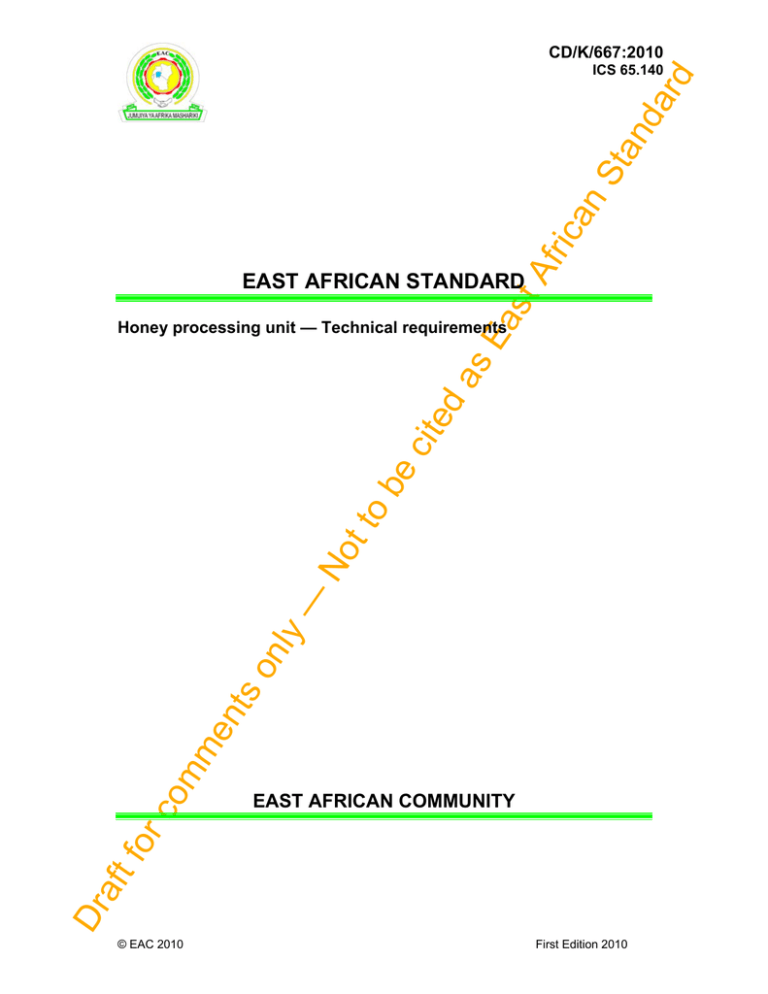
CD/K/667:2010
Af
ri c
an
St
an
da
r
d
ICS 65.140
Ea
st
EAST AFRICAN STANDARD
EAST AFRICAN COMMUNITY
Dr
a
ft f
or
co
mm
en
ts
on
ly
—
No
t to
be
cit
ed
as
Honey processing unit — Technical requirements
© EAC 2010
First Edition 2010
da
r
d
CD/K/667:2010
an
St
an
Foreword
Development of the East African Standards has been necessitated by the need for harmonizing
requirements governing quality of products and services in East Africa. It is envisaged that through
harmonized standardization, trade barriers which are encountered when goods and services are
exchanged within the Community will be removed.
st
Af
ri c
In order to meet the above objectives, the EAC Partner States have enacted an East African
Standardization, Quality Assurance, Metrology and Test Act, 2006 (EAC SQMT Act, 2006) to make
provisions for ensuring standardization, quality assurance, metrology and testing of products
produced or originating in a third country and traded in the Community in order to facilitate industrial
development and trade as well as helping to protect the health and safety of society and the
environment in the Community.
ed
as
Ea
East African Standards are formulated in accordance with the procedures established by the East
African Standards Committee. The East African Standards Committee is established under the
provisions of Article 4 of the EAC SQMT Act, 2006. The Committee is composed of representatives of
the National Standards Bodies in Partner States, together with the representatives from the private
sectors and consumer organizations. Draft East African Standards are circulated to stakeholders
through the National Standards Bodies in the Partner States. The comments received are discussed
and incorporated before finalization of standards, in accordance with the procedures of the
Community.
be
cit
Article 15(1) of the EAC SQMT Act, 2006 provides that “Within six months of the declaration of an
East African Standard, the Partner States shall adopt, without deviation from the approved text of the
standard, the East African Standard as a national standard and withdraw any existing national
standard with similar scope and purpose”.
No
t to
East African Standards are subject to review, to keep pace with technological advances. Users of the
East African Standards are therefore expected to ensure that they always have the latest versions of
the standards they are implementing.
East African Community
Arusha
Tanzania
ts
on
ly
P O Box 1096
—
© East African Community 2010 — All rights reserved*
Tel: 255 27 2504253/8
mm
en
Fax: 255-27-2504481/2504255
E-Mail: eac@eachq.org
ft f
or
co
Web: www.each.int
Dr
a
*
ii
© 2010 EAC — All rights of exploitation in any form and by any means reserved worldwide for EAC Partner States’ NSBs.
© EAC 2010 — All rights reserved
da
r
d
CD/K/667:2010
an
St
an
Introduction
Honey being a biological product tends to get spoiled due to fermentation. Processing of honey is,
thus, an essential step for apiarists, involving indirect heating of honey at conttolled temperatures to
facilitate straining, prevent fermentation by killing yeast cells and retard granulation. It is, therefore,
imperative that the honey processing unit should not be only suitably constructed but also that the
layout of processing plant should facilitate hygienic processing of honey and its quality control.
IS 14522:1998(R2004), Honey Processing Unit — Technical Requirements
Af
ri c
In the preparation of this East African Standard, the following sources were consulted extensively:
Codex Alimentarius website: http://www.codexalimentarius.net/mrls/pestdes/jsp/pest_q-e.jsp
Ea
st
USDA Foreign Agricultural Service website: http://www.mrldatabase.com
USDA Agricultural Marketing Service website: http://www.ams.usda.gov/AMSv1.0/Standards
ed
European Union: http://ec.europa.eu/sanco_pesticides/public
as
USDA Plant Inspectorate Service website: http://www.aphis.usda.gov/import_export/plants
Dr
a
ft f
or
co
mm
en
ts
on
ly
—
No
t to
be
cit
Assistance derived from these sources is hereby acknowledged.
© EAC 2010 — All rights reserved
iii
ft f
or
Dr
a
ts
on
ly
mm
en
co
—
t to
No
be
ed
cit
as
st
Ea
da
r
an
St
an
Af
ri c
d
CD/K/667:2010
da
r
d
EAST AFRICAN STANDARD
1
an
St
an
Honey processing unit — Technical requirements
Scope
2
Af
ri c
This East African Standard covers the construction aspects and layout besides other requirements for
a honey processing unit.
Normative references
Ea
st
The following referenced documents are indispensable for the application of this document. For dated
references, only the edition cited applies. For undated references, the latest edition of the referenced
document (including any amendments) applies.
ISO 1052, Steels for general engineering purposes
as
ISO 16143-1, Stainless steels for general purposes — Part 1: Flat products
ed
ISO 16143-3, Stainless steels for general purposes — Part 3: Wire
ISO 21948, Coated abrasives — Plain sheets
Location
cit
3
be
3.1
The site for construction of honey unit should be away from main township to avoid proximity
of municipal drainage, town dump, effluents, air pollution, etc.
t to
3.2
The plot should be at high level so as to preclude any possibility of underground seepage of
water in basement.
No
3.3
It should be slightly isolated from main highways or traffic lines, but should have minor feeder
approach road.
There should be ample supply of potable water.
4
Constructional requirements
4.1
level.
The honey unit should be constructed on a plinth which is at least 1 m above the ground
ts
on
ly
—
3.4
mm
en
4.2
There should be a basement with rooms to be used for separate storage of unprocessed bulk
honey, and processed honey, in various categories of packings.
4.3
There should be complete partition wall between processed and unprocessed honey storage
rooms.
4.4
co
4.3.1 In order to have lowest possible storage temperature, the processed and unprocessed honey
should be stored in the basement only.
4.5
Walls
ft f
or
Ground floor should have separate rooms for processing, filling, packing and office.
Dr
a
4.5.1 The east and west side walls should not have windows or ventilators. The walls should be
made of porous bricks plastered and painted outside with white reflecting paint so as to avoid heating
of the walls due to solar exposure.
© EAC 2010 — All rights reserved
1
d
CD/K/667:2010
an
St
an
da
r
4.5.2 The north and south side walls should carry ventilators and windows to provide uniform
adequate light with sturdy bars and sturdy fine wire mesh and glass panels so as to keep away flies,
reptiles, bees, etc.
4.5.3 The compound walls should be preferably of brick or masonry or of fine wire-mesh fencing
with well-kept green hedge.
4.6
Windows
4.7
Af
ri c
The windows and ventilators of basement and ground floor should have permanently fixed fly-proof
wire frame outside and glass panel windows opening inside.
Doors
4.8
Ea
st
All moms in the honey unit should have double doors. The outer door should he fitted with wire-mesh
and should have a self-closing device. The inner door should be an ordinary one with locking system.
Godown
ed
as
There should be a godown for storing packing material in the backyard with a separate room for
washing bottles and containers on one side and fly-proof toilet room equipped with septic tank or
underground drainage on the other side.
Plant layout
5.1
Honey processing unit generally consists of the following equipment:
Jacketed pre-heating tank,
b)
Gear pump with motor,
c)
Filter,
d)
Processing tank,
e)
Cooling tank, and
f)
Settling tanks.
—
No
t to
be
a)
cit
5
ts
on
ly
5.2
Honey processing-cum-moisture reduction unit, however, consists of the following equipment
in addition to those mentioned under 5.1:
Helical coil heat exchanger,
b)
Falling film vacuum evaporator,
c)
Falling mm heat exchanger,
d)
Jacketed vessels,
e)
Vacuum pump,
Centrifugal pump, and
Temperature indicator-cum-controller.
ft f
or
g)
co
t)
mm
en
a)
Dr
a
5.3
Layout of honey processing unit and honey processing-cum-moisture reduction unit is given
in Figure 1 and 2 respectively and is for guidance only.
2
© EAC 2010 — All rights reserved
Materials
da
r
6
d
CD/K/667:2010
an
St
an
6.1
All parts of the various equipment which come into contact with honey, should be made of
stainless steel or of food grade plastic where plastic is used.
7
Af
ri c
6.2
All parts, surfaces of which do not come into contact with honey, should be made of material
which is either corrosion-resistant or is rendered corrosion resistant by a suitable preventive treatment
on a prepared rust-free surface. For example, the outer cladding or shell of preheating tanks,
processing tanks, evaporators, other jacketed vessels may be fabricated from stainless steel or mild
or aluminium alloy.
Other requirements
The storage, processing, settling tanks, other vessels, all pipes and valves shall be leak proof.
Ea
7.2
st
7.1
Insulation to prevent heat loss should be provided to the various processing equipment,
accessories and pipe lines carrying heated honey or hot water, wherever possible.
as
7.3
Meta1lic material when used for gaskets or for sealing shall be of food grade, non-toxic, nonabsorbent, free from patches, blisters, porosity, embedded foreign matter and physical defects. The
material shall not impart any flavour or deteriorate when in contact with honey or cleaning agents.
Workmanship
ed
8
cit
8.1
Welding used for joining different stainless steel components and mild steel components shall
not be porous and shall he smooth.
Any sharp comers and protruding fasteners shall be avoided.
be
8.2
t to
8.3
All the stainless steel surfaces shall be of sanitary finish and finished smooth by buffing with
ISO 21948.
Figure 1 — Layout of honey processing plant
Dr
a
ft f
or
co
mm
en
ts
on
ly
—
No
8.4
All the mild steel parts which do not come into contact with honey shall be painted with rust
preventive anti-corrosive paint.
© EAC 2010 — All rights reserved
3
Figure 2 — Layout of honey process-cum moisture-reduction unit
Dr
a
ft f
or
co
mm
en
ts
on
ly
—
No
t to
be
cit
ed
as
Ea
st
Af
ri c
an
St
an
da
r
d
CD/K/667:2010
4
© EAC 2010 — All rights reserved
ft f
or
Dr
a
ts
on
ly
mm
en
co
—
t to
No
be
ed
cit
as
st
Ea
da
r
an
St
an
Af
ri c
d
CD/K/667:2010
© EAC 2010 — All rights reserved



